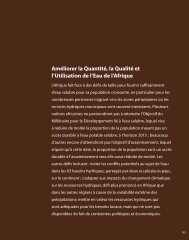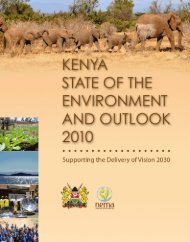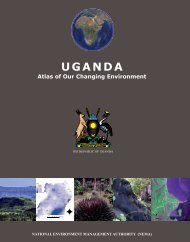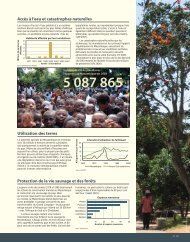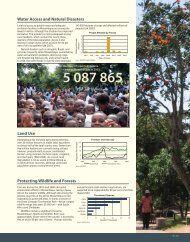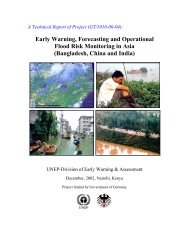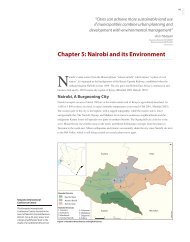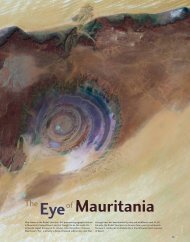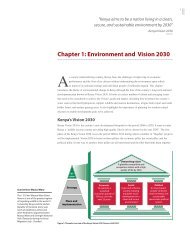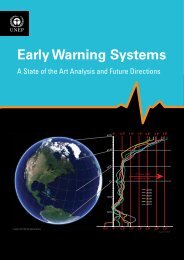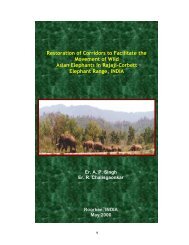To open this publication, click here... - UNEP/GRID-Sioux Falls
To open this publication, click here... - UNEP/GRID-Sioux Falls
To open this publication, click here... - UNEP/GRID-Sioux Falls
You also want an ePaper? Increase the reach of your titles
YUMPU automatically turns print PDFs into web optimized ePapers that Google loves.
Background and Introduction<br />
Introduction<br />
Article 3(3) of law N° 16/2006 of 03/04/2006 determining the organization, functioning and responsibilities of the Rwanda<br />
Environment Management Authority (REMA) obligates the organization to take stock of, and report on the state of the<br />
environment on a biennial basis. REMA is itself established by Article 65(1) of Organic Law N° 04/2005 of 08/04/2005<br />
determining the modalities of protection, conservation and promotion of the environment in Rwanda.<br />
The state of environment report for 2011 is the logical follow up to the 2009 report. In keeping with the ancient Chinese<br />
proverb that a picture is worth a thousand words, the 2011 report is deliberately presented as an environmental atlas in<br />
order to make the messages both concise and compelling. Using visualization, it is possible for the reader to grasp the gist<br />
of the environmental changes that Rwanda is undergoing without the tedium associated with combing through lengthy<br />
paragraphs of text. Thus maps, graphs and photographs are combined with brief narratives to concisely tell the story of<br />
Rwanda’s environment in ways that a largely text-based report cannot. This is especially appropriate for interrogating climate<br />
change which is arguably the most challenging environmental issue of our time.<br />
Focus of the Atlas<br />
This Atlas focuses on selected environmental hotspots for which spatial data are available. It includes data on mostly<br />
terrestrial biodiversity and landscapes although some aquatic species and natural resources are covered as well. Besides<br />
the availability of before and after data, the selection of which themes to profile and map was informed by two<br />
major considerations.<br />
The first was to flag adverse environmental developments that require urgent attention in order to prevent them from<br />
spiralling out of control. The second was to showcase Rwanda’s innovative environmental policies, programmes and<br />
initiatives, many of which have won internationally acclaimed awards. Successes in implementing the plastic bags ban, in<br />
reversing massive deforestation, in instituting monetary and fiscal discipline, in attaining gender parity at several decision<br />
making levels and in harnessing ICT have transformed Rwanda into a model nation at many levels. These accomplishments<br />
essentially prove that environmental and associated development challenges can be overcome. This is especially important<br />
given the inextricable linkages between the environment, development and peace which were fully articulated at the 1992<br />
Earth Summit in Rio de Janeiro.<br />
The overarching goal of <strong>this</strong> Atlas is to show the environmental changes that are taking place in Rwanda. These are<br />
interwoven with the climate change theme with specific emphasis on the associated vulnerabilities as well as the mitigative<br />
and adaptive opportunities that arise. Tapping these will ensure a low carbon, climate change resilient development<br />
path for the country. Moreover, enhancing Rwanda’s climate change mitigative and adaptive capacities was one of key<br />
recommendations of <strong>this</strong> Atlas’ predecessor, the 2009 SOE report.<br />
The focus on climate change is also predicated on the fact that in 2001, climate hazards ranked third among the 10 top<br />
causes of poverty in Rwanda (RoR 2005). As a decade has passed since then, it is highly plausible that these climate change<br />
impacts have generally heightened rather than abated. Moreover, although Rwanda is a low-carbon economy and is one<br />
of the world’s lowest greenhouse gas (GHG) emitters, it is among those most vulnerable to climate change. This is because<br />
several parts of the country such as Bugesera, the Eastern Curve, Southern Plateau and lake shore regions are already<br />
dangerously close to the water availability, heat tolerance and food security thresholds. The projected intensification of<br />
major climatic events such as droughts and floods are bound to exacerbate the associated vulnerabilities (SEI 2009).<br />
The Atlas also provides a reflection on the progress made towards attaining Rwanda’s development goals outlined in Vision<br />
2020 and EDPRS. As elaborated in the Atlas’ Chapter One, recent monitoring through the EDPRS framework indicates that<br />
Rwanda is firmly on course to meeting its Vision 2020’s sectoral targets. Nevertheless, the evaluation results presented at<br />
the 2010 senior leadership retreat demonstrated that progress towards achieving the poverty, population and environment<br />
targets was still off-track. The analyses in <strong>this</strong> Atlas underline the urgent need to formulate and implement policy<br />
responses intended to promote environmental sustainability. Some of the strong policy responses include the integration<br />
of environment and climate change priorities in the 2011/2012 budget call circular (BCC) by the Ministry of Finance and<br />
Economic Planning (MINECOFIN). Further, the recent formulation of the Green Growth and Climate Resilience: National<br />
Strategy for Climate Change and Low Carbon Development (CCLCD) is also intended to ensure resilience in livelihoods and<br />
economic sectors.<br />
vii



